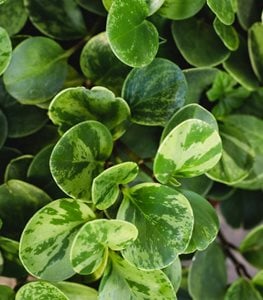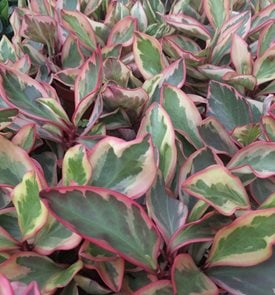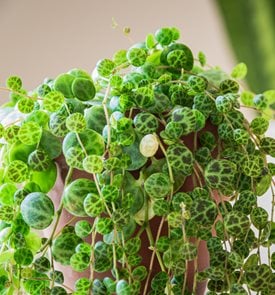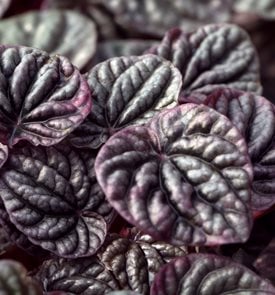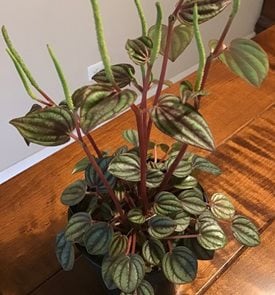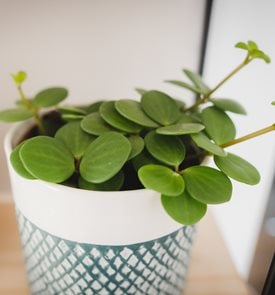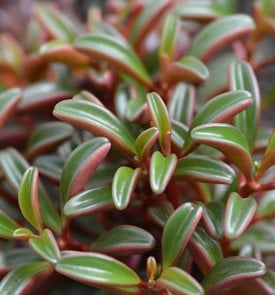A Guide to Growing Peperomia Plants
Get growing and care tips for this versatile and easy-to-grow houseplant, along with a look at some of the most popular varieties.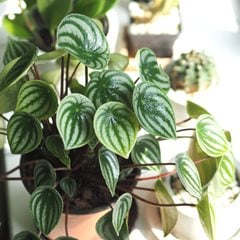
Watermelon peperomia. Photo by: Ladydoubt / Shutterstock
If variety is the spice of life, then Peperomia is the perfect houseplant to add zest to your indoor (or outdoor) container arrangements. Few plants offer so many options in foliage color, shape, size, and texture, from the glossy succulent-like leaves of baby rubber plant (P. obtusifolia) to the deeply fissured heart-shaped foliage of ‘Red Ripple’ (P. caperata).
You can choose from a wide range of growth habits too, from small, mounding types that tuck neatly into terrariums to trailing plants ideal for hanging baskets. Can’t decide on a favorite? Then splurge and bring home several. These compact houseplants are great for mixing and matching, allowing you to create a showy display by combining peperomias in an assortment of colors, textures, and forms.
On this page: Basics | Growing | Care | Varieties | Troubleshooting
On this page:
PEPEROMIA BASICS
Botanical name:
Peperomia obtusifolia
Common names:
Peperomia, baby rubber plant, radiator plant
Origin:
Subtropical and tropical regions of Central and South America
Growth rate:
Slow growing
Size:
Under 6 inches up to a foot, depending on the variety
Foliage:
Usually thick, waxy and succulent-like, with textures ranging from smooth and flat to deeply rippled. Leaf shape can vary as well, and may be oval, round, pointy, or heart-shaped. Foliage colors range from solid green to variegated or striped patterns sporting silver, white, pale yellow or deep red markings.
Flowers:
Under ideal growing conditions, peperomia will sometimes produce long, spiky, mouse tail-like blooms, usually green or creamy white in color. It’s a special treat when they do, and the blooms will often last for several weeks.
Special attributes:
- Improves indoor air quality by filtering out airborne toxins
- Easy to propagate from stem or leaf cuttings
- Can be grown outdoors in summer months, or year-round in warmer climates (Zones 10-12)
- Pet friendly
GROWING PEPEROMIA
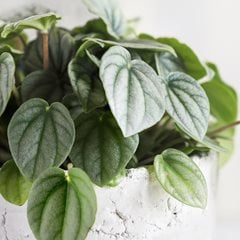
'Frost' peperomia. Photo by: Stephanie Frey / Shutterstock
Light:
For the best leaf color, grow under bright, indirect light, such as from an east- or west-facing window. Can also be grown under fluorescent lighting. Avoid direct sunlight, which can burn the leaves.
Temperature:
Peperomias are also called radiator plants because they crave warm growing conditions. Indoors, grow at room temperatures of 65°F to as high as 80°F. If you put your plant outdoors during the summer, be sure to bring it back inside before temperatures fall below 50°F.
Humidity:
Because peperomias are native to tropical regions, they prefer moderate to high humidity and thrive in places like terrariums and brightly lit bathrooms. In drier areas of the home, you can keep your plants hydrated by misting the leaves or setting them on a tray filled with pebbles and water.
Soil type:
Use a well-draining potting mix, preferably one containing coco fiber and perlite to keep the soil loose and aerated.
Pot requirements:
As with most houseplants, be sure to use a pot with drainage holes to prevent soggy soil and root rot. Peperomia don’t mind being a bit cramped in their homes, so choose a container that is only slightly larger than your plant’s root ball.
PEPEROMIA PLANT CARE
Watering:
Because of its succulent-like qualities, peperomia stores water in its thick leaves and stems and doesn’t require frequent watering. Aim for giving it a drink every seven to ten days, or when the top inch or two of soil feels dry to the touch. Be careful not to overwater, which can lead to root rot.
Fertilizing:
Apply a diluted liquid fertilizer once every month or so from early spring through late summer. Do not fertilize in winter.
Pruning and shaping:
If you want to give your Peperomia a bushier appearance or prevent it from becoming too leggy, pinch it back just above a leaf node to encourage new growth and branching. You can use the clippings to propagate more plants.
Leaf care:
Peperomias with large leaves, such as ‘Ginny’ (P. clusiifolia), benefit from an occasional cleaning with a damp cloth to keep the foliage nice and shiny. For species with grooves or ripples in their leaves, the best cleaning method is to mist the leaves occasionally with room-temperature water to remove dust buildup in the crevices.
Repotting:
Because of its slow growth rate, peperomia can go for years before it needs repotting and actually prefers being a bit rootbound. When you do repot, move your plant to a container that is only slightly larger.
Propagation:
Place stem or leaf cuttings (best taken in spring or early summer) in a glass of water or into some moist potting soil and give them bright, indirect light. New roots should develop within a few weeks. To speed up the rooting process, you can dip the bottom of the stem in some rooting powder before planting.
Pests:
Peperomias are usually pest-free, but be on the lookout for mealybugs, whiteflies, and spider mites. (See more on common houseplant pests.)
PEPEROMIA VARIETIES
COMMON PROBLEMS WITH PEPEROMIA
Peperomias are usually fuss-free and easygoing, but like most houseplants, their health can suffer when grown under less-than-optimal conditions. Here are some of the common warning signs to look for:
- Leaves falling off: It’s normal for a peperomia plant to lose some of its lower, older leaves, but a continual shedding of foliage is cause for concern. Typically a loss of leaves is due to stress caused by sudden temperature fluctuations, overfeeding, or overwatering. Also check for signs of pests and diseases.
- Washed-out color: Peperomias with variegated patterns may lose some of their vibrancy if they don’t get enough light. Try moving your plants closer to a window or grow them under fluorescent lighting or LED grow lights.
- Leggy growth: Most likely the leaves of your peperomia are stretching towards the light. Move the plant closer to the light source and rotate it regularly to give the leaves even light exposure.
- Yellowing leaves: Usually a sign of overwatering, especially if the stems are turning brown and mushy. Prune off the damage and wait until your plant dries out before watering again. You may also need to change the soil and repot your plant to prevent root rot.
- Brown or crispy leaves: Probably due to low humidity or exposure to bright sunlight. Move your plant to a location that receives indirect light, and if the air is dry, mist the leaves occasionally. If the soil feels dry, you may be under watering.
RELATED:
21 Best Indoor Plants
Best Low-Light Houseplants
Top 16 Terrarium Plants
A Guide to Growing Pothos

